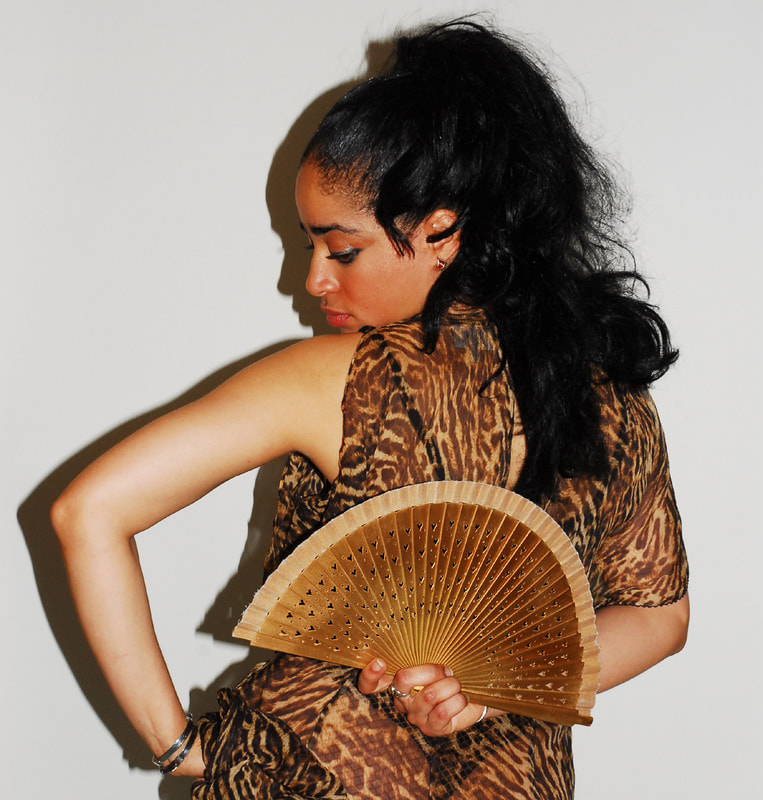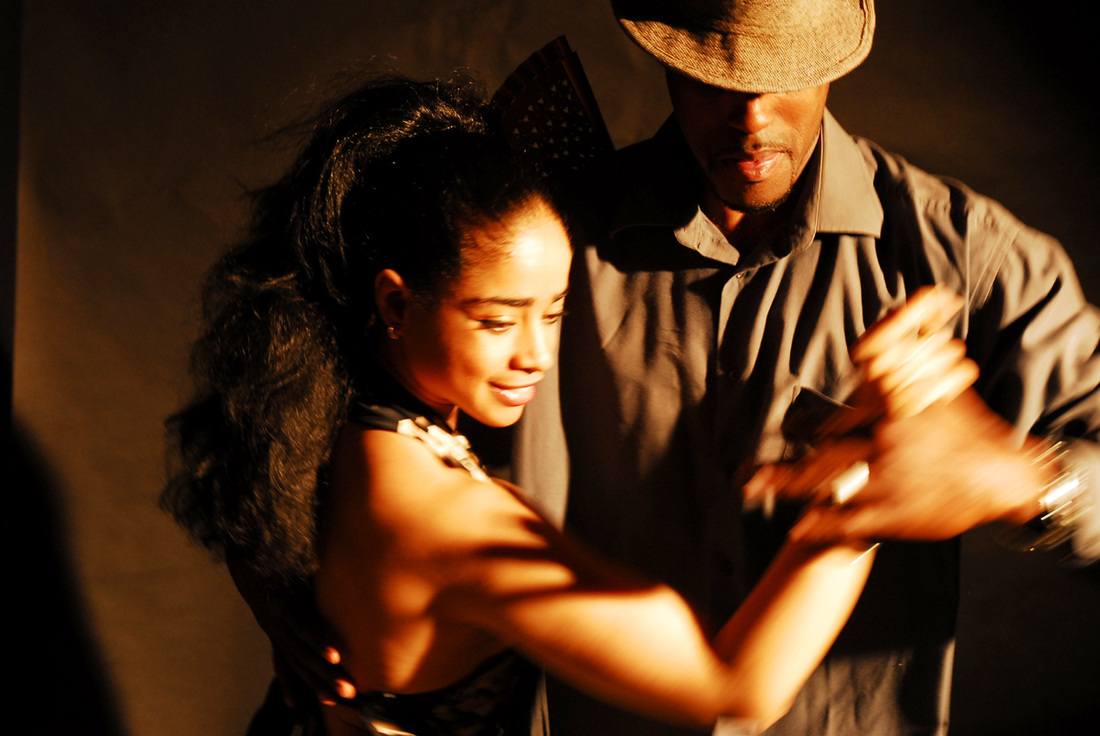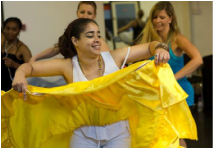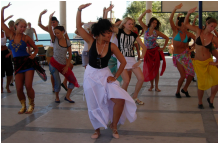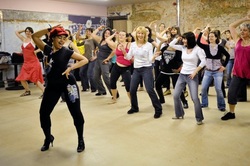Improve your Cuban Dance and Musicality knowledge, with D'Masters of "EN-FAMiLiA" program , Sunday 30th of August 2020
Note: As part of the "EN-FAMiLiA" Project (LiveStream) Fridays , 7.30pm UK-Time from DCubanSchool facebook group (click for more info) We decided to add an ONLINe version of our Puro Sabor Cubano with D'Masters of "EN-FAMiLiA" in order to merge and contribute with the experience in a Dance and Musicality level .
Puro Sabor Cubano (Online workshop version) will run now on Sunday 30th of August from 11am -8.30pm UK-Time (depending on the programme) which will work in accordance to the topic of the "EN-FAMiLiA" project.
Puro Sabor Cubano (Online workshop version) will run now on Sunday 30th of August from 11am -8.30pm UK-Time (depending on the programme) which will work in accordance to the topic of the "EN-FAMiLiA" project.
Improve your Cuban Dance and Musicality knowledgePassionate about Cuban Dance, Music, history? Intrigued of that extra which make the dance an amazing and uplifting experience? Hungry for knowledge ?...
Then Puro Sabor Cubano (Pure Cuban Flavour) workshops is that component missing in your life. With PSC you'll get the whole package: professional qualified teachers, technique, musicality, dance history knowledge, challenging, fun, movements, Mindfulness , space awareness and more... What you will learnWhat you learnt during the Puro Sabor Cubano workshops, would depend on the date you select as workshops are tailored and varies in accordance to the dance style selected and the teachers.
Focus is placed on teaching more than the basic moves from the specific dance style description correctly so you can have a full experience of Cuban Dance, Music, Culture and some history. The workshop will help you improve your posture, confidence, styling, personal interpretation of moves, shines and footwork, turns, and Much More... Why Puro Sabor Cubano with us?Pure Cuban Flavour has it all. Flavour, sabor, heat and corporal expression. Classes are designed to help you become a more confident and knowledgable dancer, and in some cases even a better teacher and performer. To get not only the dance steps, but overall understanding of the dance style, music genre, style and improvisation technique to shine on the dance floor. Cuba at it's best!
TOP UK Native Cuban born DANCE Teachers, Professional dancers and ESTEEMED choreographers. Classes are held ONLINe due to current situation. Great value for money. Workshops are level tailored. But we welcome all levels ( unless specify) as we have our own levelling system and dived classes when needed. Please check the description and contact us if you have any doubts. New - WE WILL BE RUNNING A WHOLE-DAY WORKSHOP ON SUNDAY 30th AUGUST with D'Masters of EN-FAMiLiA - Over 15years experience each |
Start your Puro Sabor Cubano workshop experience with one of these classes |
No dance partner neededCome on your own or join us with a group of friends.
|
All dance levels welcome
|
Flexible payment optionsWhether you want to join us for a single class or pay for a few workshops with a discount.
|
Time & LocationOnline
Sundays, 11am-8.30pm check programe |
TestimonialsOn of the best Rumba and Afro-Cuban Workshops Online. Thought with great detail and passion. Highly recommended. Great classes!! The teachers were amazing. I now understand more about the different dance styles that come from Cuba. Did not that there were such a variety of dance and music. I meet a lot of new people and made friends. |
What is Puro sabor cubano master WORKSHOP?
Puro Sabor Cubano ( Pure Cuban Flavour ) master workshops are set of dance and or music master-classes with a deeper and more structured , concise information about the rich world of Dance that Cuba has to offer.
Created and organised by Damarys Farres, Director of the Cuban School of Arts, in association with Top UK & International Cuban born dancers and artists, some who are now part of DCubanSchool of Arts Artists and teachers Association.
Created and organised by Damarys Farres, Director of the Cuban School of Arts, in association with Top UK & International Cuban born dancers and artists, some who are now part of DCubanSchool of Arts Artists and teachers Association.
What CAN YOU EXPECT during the Master Workshop ?
- Energy, technique, joy and excellence in dance and music
- Body isolation technique, musicality, history and stories
- Flavour, heat and corporal expression. Cuba at it's best !
- Incorporating footwork and corporal expression that will enrich any other dance form that you might enjoy, this workshop will help you with your confidence, style and improvisation on the dance floor.
- Hours of Pure Cuban Flavour in suitable venue, mainly dance studios.
- Some classes accompanied by live music.
- Much more than the learning of different styles of dance steps
- Hours of Intensive & Revolutionary CUBAN DANCE and CULTURE!
- TOP UK Native Cuban DANCE Teachers, Professional dancers and ESTEEMED choreographers
- Great Value for money
WHAT IS SON CUBANO ?
Son cubano is a genre of music and dance that originated in the highlands of eastern Cubaduring the late 19th century. It is a syncretic genre that amalgamates elements of Spanish and African origin. Among its fundamental Hispanic components are the vocal style, lyrical metre and the primacy of the tres, derived from the Spanish guitar. On the other hand, its characteristic clave rhythm, call and response structure and percussion section (bongo, maracas, etc.) are all rooted in traditions of Bantu origin.[1]
Around 1917 when the Danzon was the most popular national dance in Cuba, a new musical style known as the Cuban Son appeared in Havana. The Son was accepted with such enthusiasm that soon it became very popular without taking anything away from the Danzon. The Danzon, which had been the national dance of Cuba since 1879, could be found everywhere from the popular dance halls to upper class social clubs. The Son had the same elements as the Danzon but was different in its form. It is due to the Son that the African instruments came to light to animate the orchestras that were prevalent and typical at the time in Havana. These instruments exposed the deep currents of African rhythms in Cuba brought over by the slaves on their painful journey from Africa. Although the Son was accompanied only by percussion it also had its own distinct music and sound. However, in the Son, it is the rhythm that is most prominent. The Son originated in the Eastern region of Cuba, known as the Oriente Provence, among the country folk. This was probably due to the influence of the freed African slaves that arrived shortly after their emancipation from the French in Hispañola (now Haiti and the Dominican Republic.)
It was around this time that several other instruments also appeared. The bongos (which are pressed between the knees and struck with one or more fingers), the marimbula, the quijada, the timbales criollos, the cowbell (which is played using a small metal bar), the botijuela (a wide earthen jar which is played by applying ones lips and blowing air through the thin opening at its neck) and the diente de arado (which sounds like a deep cowbell), were all introduced into popular Cuban music through the Son. Cubans also discovered the musical potential of a type of hardwood used for building boats, and from this the claves were born. The claves are a pair of cylindrical wooden sticks which when struck together produce a metallic sound that rises above all other instruments. The claves are the key to keeping the rhythm of the Cuban Son, and they also direct the dancers footsteps. In addition there are the palmadas (hand claps) as well as the guiros, the maracas, the guitar and its derivative, a Cuban innovation known as the tres. This is the battery of rhythmic instruments that have accompanied the Son since it came into being in 1920 and lasted until 1930.
In Havana, the trumpet was also added to the Son. The botijuela was replaced by the double bass, and the claves kept the rhythm with the bongo drums. Various foreign composers that visited Cuba and heard the typical way of playing the Son were impressed with its rhythm. One of them, the American composer George Gershwin, incorporated the Son written by Ignacio Piñero entitled "Echale Salsita" as the principal theme for his work Opertura Cubana. The Sons which were maintained in their purest form came from the Oriente Provence. These Sons were mainly influenced by French blacks who came from Santo Domingo. The composers from Havana sometimes produced Sons closer in form to the Canción.
The form of the Son is not complicated. It consists of the repetition of a chorus (el estibio) of four bars that since the beginning have been known as the Montuno, a chorus sung in response to a soloist. In its purest form it consists of the "largo" and the "montuno." The largo is initially recited in a single voice and is followed by the call and response of the percussion and voices in the "montuno".
There is evidence that suggests that the Son was born at the end of the nineteenth century in the mountains of the Oriente Provence and acquired its distinctive musical personality in Havana in the 1920s. Some musicologists attribute the Son’s arrival in Havana to members of the Cuban army from the Oriente Provencethat were transferred to Havana and the Matanza Provence. It should be noted that this popularity was defined by the formation and success of the SextetoHabanero, the many prizes they received, their trips abroad, their recordings, their famous Sons and their participation in many popular films. Although it appeared between 1917 and 1920, this form of call and response already existed in the Son, "Ma Teodora" which was composed by the elder of the Gines sisters, Teodora. It is almost certain that is the first Son ever to have been written down, although the notable musicologist Eduardo Sanchez de Fuentes has stated that it has a decided aboriginal influence based on the form of the Areito found by Christopher Columbus in Cuba and danced by the native peoples. It should be noted that this Son was composed by Teodora Gines on her "bandola" in the region of Baracoa which coincides with the fact that the Son as we know it was born in Baracoa Oriente.
The musical movement of the Son was so creative and convincing that it was capable of producing its own instruments, interpreters, authors and even its own original choreography.
Around 1917 when the Danzon was the most popular national dance in Cuba, a new musical style known as the Cuban Son appeared in Havana. The Son was accepted with such enthusiasm that soon it became very popular without taking anything away from the Danzon. The Danzon, which had been the national dance of Cuba since 1879, could be found everywhere from the popular dance halls to upper class social clubs. The Son had the same elements as the Danzon but was different in its form. It is due to the Son that the African instruments came to light to animate the orchestras that were prevalent and typical at the time in Havana. These instruments exposed the deep currents of African rhythms in Cuba brought over by the slaves on their painful journey from Africa. Although the Son was accompanied only by percussion it also had its own distinct music and sound. However, in the Son, it is the rhythm that is most prominent. The Son originated in the Eastern region of Cuba, known as the Oriente Provence, among the country folk. This was probably due to the influence of the freed African slaves that arrived shortly after their emancipation from the French in Hispañola (now Haiti and the Dominican Republic.)
It was around this time that several other instruments also appeared. The bongos (which are pressed between the knees and struck with one or more fingers), the marimbula, the quijada, the timbales criollos, the cowbell (which is played using a small metal bar), the botijuela (a wide earthen jar which is played by applying ones lips and blowing air through the thin opening at its neck) and the diente de arado (which sounds like a deep cowbell), were all introduced into popular Cuban music through the Son. Cubans also discovered the musical potential of a type of hardwood used for building boats, and from this the claves were born. The claves are a pair of cylindrical wooden sticks which when struck together produce a metallic sound that rises above all other instruments. The claves are the key to keeping the rhythm of the Cuban Son, and they also direct the dancers footsteps. In addition there are the palmadas (hand claps) as well as the guiros, the maracas, the guitar and its derivative, a Cuban innovation known as the tres. This is the battery of rhythmic instruments that have accompanied the Son since it came into being in 1920 and lasted until 1930.
In Havana, the trumpet was also added to the Son. The botijuela was replaced by the double bass, and the claves kept the rhythm with the bongo drums. Various foreign composers that visited Cuba and heard the typical way of playing the Son were impressed with its rhythm. One of them, the American composer George Gershwin, incorporated the Son written by Ignacio Piñero entitled "Echale Salsita" as the principal theme for his work Opertura Cubana. The Sons which were maintained in their purest form came from the Oriente Provence. These Sons were mainly influenced by French blacks who came from Santo Domingo. The composers from Havana sometimes produced Sons closer in form to the Canción.
The form of the Son is not complicated. It consists of the repetition of a chorus (el estibio) of four bars that since the beginning have been known as the Montuno, a chorus sung in response to a soloist. In its purest form it consists of the "largo" and the "montuno." The largo is initially recited in a single voice and is followed by the call and response of the percussion and voices in the "montuno".
There is evidence that suggests that the Son was born at the end of the nineteenth century in the mountains of the Oriente Provence and acquired its distinctive musical personality in Havana in the 1920s. Some musicologists attribute the Son’s arrival in Havana to members of the Cuban army from the Oriente Provencethat were transferred to Havana and the Matanza Provence. It should be noted that this popularity was defined by the formation and success of the SextetoHabanero, the many prizes they received, their trips abroad, their recordings, their famous Sons and their participation in many popular films. Although it appeared between 1917 and 1920, this form of call and response already existed in the Son, "Ma Teodora" which was composed by the elder of the Gines sisters, Teodora. It is almost certain that is the first Son ever to have been written down, although the notable musicologist Eduardo Sanchez de Fuentes has stated that it has a decided aboriginal influence based on the form of the Areito found by Christopher Columbus in Cuba and danced by the native peoples. It should be noted that this Son was composed by Teodora Gines on her "bandola" in the region of Baracoa which coincides with the fact that the Son as we know it was born in Baracoa Oriente.
The musical movement of the Son was so creative and convincing that it was capable of producing its own instruments, interpreters, authors and even its own original choreography.
SON CUBANO TRADITIONAL INSTRUMENT
MORE ABOUT YOUR DCubanschool "masters" aSSOCIATES I
|
DAMARYS FARRES
Havana, Cuba Damarys Farrés is the Director and sole founder of D'CubanSchool. It has been said that 'Damarys is a unique dancer, who captures the soul and spirit of Cuba in her dancing'; and that 'Damarys affects everybody with her vital energy, passion and happiness!' Damarys is a knowledgable passionate dancer, choreographer, teacher and researcher of the Cuban and Afro-Cuban culture dance forms and rhythms. These include Salsa, Son, Rumba, Yoruba, Bantu, Arara, Regaetton among other genres. Damarys is highly acclaimed in UK as well as worldwide for her charisma and her infectious energy. She is renowned for her knowledge and passion for the Cuban and Afro-Cuban culture, dance forms and her femininity. She has a unique dancing style, choreography, artistic direction and teaching, which owes much to her broad background in dance. This includes classical ballet, contemporary, jazz, hip-hop, reggaetton, traditional and popular Cuban styles, folk dances, as well as other Latin, modern and Afro-Cuban dances. She was the first female Cuban artist to provide structured Cuban dance rhythm courses in the UK. She was the first solo Cuban Artist to organise independent Cuban cultural events involving Cuban artists in the UK, hence our slogans “110% Cubano” - “110% Genuine Cuban!” Her passion for her culture and Cuban dance, especially traditional and Afro-Cuban dance, are her main motive for founding The Cuba School of Arts - The Home of Cuban Arts in the UK. More about Damarys: Click here |
|
JUAN CARLOS
Havana , Cuba Juan Carlos Pacheco is a Professional Cuban Dancer and Choreographer. He studied all forms of Cuban Traditional Dance from all the venerable Masters for 21 years, mainly in Havana, Cuba, and was a regular performer with the Buena Vista Social Club. Juan Carlos started his dance studies at the National School of Ballet in Havana, from the age of 7 until the age of 11. He then went on to study at the National School of Art and has a qualification from the Superior Art Institute of Cuba. He has danced with the Muñequitos de Matanzas (Rumba/Columbia/Guaguanco) and with the Conjunto Folklorico Nacional de Cuba. He has performed in shows with the world famous Buenavista Social Club and Conjunto Chapotin and his Star, Septeto Habanero, Havana Casino, Van Van 1999 La piragua, Anjel Bonne and his Band, Casa de la Musica and Okay Cuba, and many others. Juan Carlos has also appeared on many Cuban TV programmes, including the “Palmas y Cañas” TV programme, Para Bailar 1982, a festival celebrating Cuban Music, a country music festival, De la gran Escena, and with the Cuban TV Ballet Company. He has also Danced alongside the famous Hermanos Santos, and at the Hotel Inglaterra, Hotel Nacional, Hotel Triton, and the Hotel Riviera in downtown Havana, a formidable venue for traditional Cuban Culture. He is now part of DCubanSchool of Arts teachers associated and performed and run regular Son and traditional dance workshops with Damarys Farres. ( Check them in action) |
What is Puro sabor cubano master workshop?
Puro Sabor Cubano ( Pure Cuban Flavour ) workshops are set of dance and or music workshop with a deeper and more structured , concise information about the rich world of Dance that Cuba has to offer.
Created and organised by Damarys Farres, Director of the Cuban School of Arts, in association with Top UK and International Cuban born dancers and artists.
Created and organised by Damarys Farres, Director of the Cuban School of Arts, in association with Top UK and International Cuban born dancers and artists.
What CAN YOU EXPECT during the workshops ?
- Energy, technique, joy and excellence in dance and music
- Flavour, heat and corporal expression. Cuba at it's best !
- Incorporating footwork and corporal expression that will enrich any other dance form that you might enjoy, this workshop will help you with your confidence, style and improvisation on the dance floor.
- 2 hours of ONLiNe Pure Cuban Flavour.
- Much more than the learning of different styles of dance steps
- Hours of Intensive & Revolutionary CUBAN DANCE and CULTURE!
- TOP UK and well Known International Native Cuban DANCE Teachers, Professional dancers and ESTEEMED choreographers
- Great Value for money
Cuban music
Cuban music is a myriad of styles and genres with a long history. While influences from Africa and Spain were predominant, Cuban music has also been shaped by the music of Europe, Latin-America and American pop music and Jazz.
We are well know for our Son "Buena Vista Social Club" , Rumba and Timba or Salsa.
We are well know for our Son "Buena Vista Social Club" , Rumba and Timba or Salsa.
WHAT WOULD YOU BE LEARNING AT THE PURO SABOR CUBANO WORKSHOP?
What you learnt during the Puro Sabor Cubano workshops, would depend on the date you select, as workshops are tailored and varies in accordance to the dance style selected and the teachers.
Please read the PSC description to avoid confusion, and join us on Friday "EN-FAMiLiA" LiveStream Project. We guaranteed that you will learn something new each time you join us.
Please read the PSC description to avoid confusion, and join us on Friday "EN-FAMiLiA" LiveStream Project. We guaranteed that you will learn something new each time you join us.

